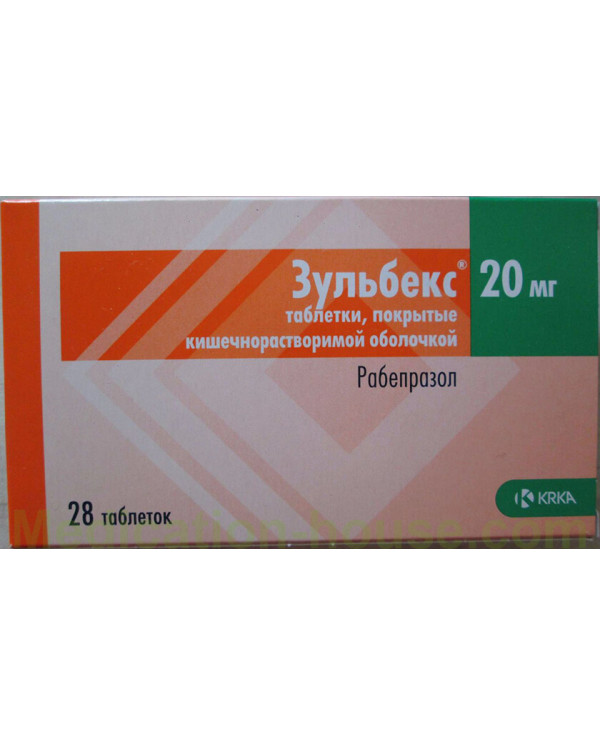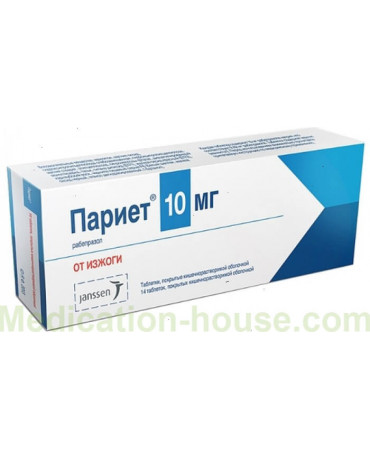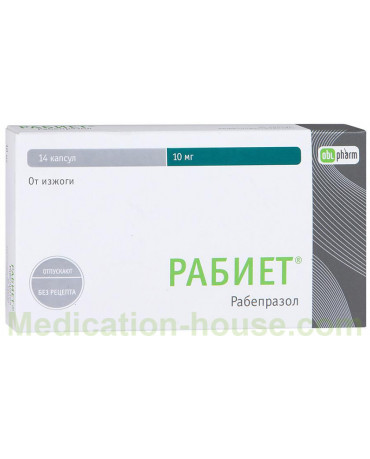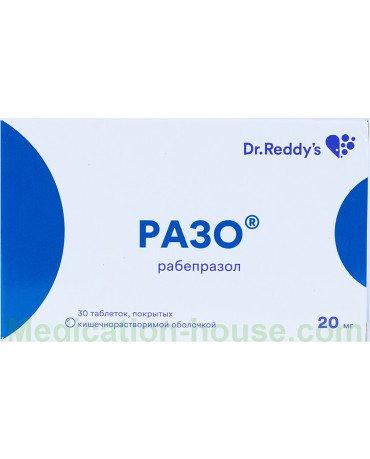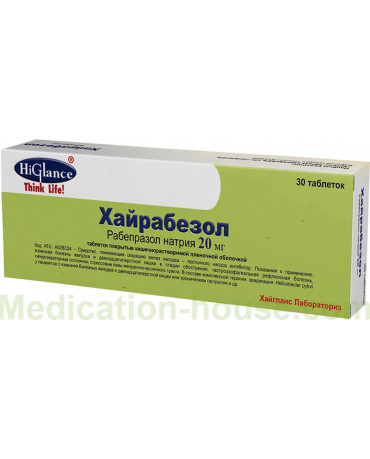Zulbex instruction
You can buy Zulbex here
Zulbex - proton pump inhibitor; an agent that reduces the secretion of the glands of the stomach.
Release form and composition
Dosage form - enteric coated tablets: round, convex on both sides, orange-pink (10 mg tablets) or brownish-yellow (20 mg tablets), 10 mg tablets with a bevel (14 and 15 pcs each in blisters) , 1, 2 or 4 blisters are packed in a cardboard box).
Composition of 1 tablet:
active substance: rabeprazole sodium - 10 or 20 mg (which corresponds to the content of rabeprazole 9.42 and 18.85 mg, respectively);
auxiliary components: hyprolose, low substituted hyprolose, mannitol (E421), lightweight magnesium oxide;
bonding layer of the shell: lightweight magnesium oxide, ethyl cellulose;
enteric coating: talc, titanium dioxide (E171), diacetylated monoglycerides, hypromellose phthalate, yellow iron oxide (E172), red iron oxide (E172).
Pharmacodynamics
Rabeprazole is a drug from the class of antisecretory drugs, substituted with benzimidazoles that do not have antihistamines (H2) and anticholinergic properties, but inhibit gastric secretion by inhibiting the proton pump (H + / K + -ATPase enzyme). Zulbex has a dose-dependent effect, suppresses basal and stimulated secretion of hydrochloric acid in the stomach, regardless of stimulating factors. According to animal studies, rabeprazole quickly disappears from the mucous membrane of the stomach and blood plasma. Being a weak base, the substance in any dose is rapidly absorbed and accumulates in the acidic environment of the parietal cells of the stomach. Then, by protonization, it is converted to the sulfenamide form, after which it interacts with the available cysteine molecules of the proton pump.
The antisecretory effect of Zulbex develops within 1 hour after ingestion of 20 mg, reaches a maximum after 2-4 hours. 23 hours after the first dose, the suppression of stimulated food and basal secretion of hydrochloric acid in the stomach is 82 and 69%, respectively, and lasts up to 48 hours. With regard to the secretion of hydrochloric acid when taking repeated doses, the inhibitory effect of the drug increases slightly and reaches its equilibrium state after 3 days. After discontinuation of rabeprazole, the secretory activity of the stomach is restored within 2-3 days.
According to in vitro studies, rabeprazole has a bactericidal effect on the bacterium Helicobacter pylori. With its eradication by a combination of rabeprazole with antimicrobials, a high degree of healing of lesions of the mucous membrane is noted. According to clinical studies, the use of rabeprazole in a dose of 20 mg 2 times a day simultaneously with two antibiotics (for example, metronidazole and clarithromycin or amoxicillin and clarithromycin) for 1 week in patients with gastroduodenal ulcers can destroy H. pylori by more than 80% . In choosing the optimal combination in this case, it is necessary to be guided by the approved treatment standards. In the case of persistent infection (initially sensitive strains of microorganisms), when choosing a dosage regimen, the risk of developing secondary antibiotic resistance should be considered.
In clinical trials in patients receiving 10 or 20 mg of rabeprazole 1 time per day for a period of up to 43 months, the concentration of gastrin in the serum increased in the first 2-8 weeks, which reflects the inhibitory effect on the secretion of hydrochloric acid, with continued therapy remained stable and returned to baseline values usually within 1–2 weeks after drug withdrawal.
According to the results of studies of biopsy samples from the bottom of the stomach and antrum of more than 500 patients who received rabeprazole or comparative treatment for up to 8 weeks, there were no changes in the histological and ECL cell structure, the degree of gastritis, the incidence of intestinal metaplasia or atrophic gastritis , the prevalence of H. pylori. More than 250 patients who were followed up for 36 months of treatment showed no significant changes in the initial conditions.
Systemic effects of rabeprazole in relation to the cardiovascular, central nervous and respiratory systems to date have not been identified. When taking Zulbex at a dose of 20 mg for 2 weeks, there was no effect on thyroid function, carbohydrate metabolism, circulating concentrations of somatotropic hormone, aldosterone, follicle-stimulating hormone, renin, secretin, luteinizing hormone, testosterone, estrogen, prolactin, cortisol, glucone cholecystokinin, parathyroid hormone.
Pharmacokinetics
Zulbex is available in the form of enteric-coated tablets (i.e., stable in the stomach), since rabeprazole is unstable in an acidic environment. Therefore, the absorption of the active substance begins in the intestine. Cmax (maximum concentration) of rabeprazole in blood plasma is achieved 3.5 hours after taking 20 mg. AUC (the area under the concentration-time curve) and Cmax are linear in the dose range from 10 mg to 40 mg. The absolute bioavailability of 20 mg of rabeprazole after oral administration is about 52% compared with intravenous administration. With repeated administration, bioavailability is not expected to increase. The half-life of the drug from blood plasma in healthy people is about 1 hour, the total clearance is 283 ± 98 ml / min. The time of taking Zulbex and food do not affect the absorption of rabeprazole.
Communication with plasma proteins is approximately 97%.
Rabeprazole is metabolized in the liver with the participation of CYP450 isoenzymes of cytochrome P450. In vitro studies have found that in the expected plasma concentrations in humans, the drug did not affect CYP3A4, and this indicates the absence of interaction of rabeprazole and cyclosporine. The main metabolites found in plasma are carboxylic acid (M6) and thioester (M1), sulfonic (M2), desmethyl-thioether (M4) and conjugate with mercapturic acid (M5) are determined in smaller quantities.
About 90% of the dose taken is excreted by the kidneys in the form of two metabolites: a carboxylic acid (M6) and a conjugate with mercapturic acid (M5), as well as two unknown metabolites. The rest of the substance taken is found in the intestinal contents.
In the pharmacokinetic parameters of rabeprazole at a dose of 20 mg, no gender differences were found taking into account adjustments for body weight and patient height.
With renal failure in patients undergoing hemodialysis (creatinine clearance <5 ml / min / 1.73 m2), the distribution of rabeprazole is similar to those in healthy volunteers, and Cmax and AUC are approximately 35% lower than these parameters in healthy people. The half-life of rabeprazole averages 0.82 hours in healthy volunteers, 0.95 hours in patients on hemodialysis, and 3.6 hours after hemodialysis. The clearance of rabeprazole in hemodialysis patients due to functional renal impairment is approximately 2 times higher than in healthy people.
With mild and moderate hepatic impairment, after a single dose of 20 mg of rabeprazole, AUC increases 2 times, Cmax - 2-3 times compared with healthy volunteers, after regular administration of rabeprazole at a dose of 20 mg for 7 days, the AUC increases by 1, 5 times, Cmax - 1.2 times. The pharmacodynamic response of patients (monitoring the pH of the stomach) is clinically comparable in both groups. The half-life for impaired liver function is 12.3 hours, while in healthy people it is 2.1 hours.
In elderly patients, the elimination of rabeprazole is somewhat slower. When taking Zulbex in a daily dose of 20 mg for 7 days, AUC increases by about 2 times, Cmax - by 60%, half-life - by 30%. No evidence of drug accumulation was noted.
In patients with a slowed metabolism of CYP2C19 after taking 20 mg of rabeprazole AUC and a half-life is approximately 1.9 and 1.6 times higher than in those with an active metabolism, Cmax increases by 40%.
Indications for use
Zollinger-Ellison syndrome;
exacerbation phase of gastric ulcer and duodenal ulcer;
gastroesophageal reflux disease (GERD): treatment of erosive reflux esophagitis and symptomatic therapy of GERD, including long-term maintenance;
complex therapy for the eradication of Helicobacter pylori in patients with peptic ulcer of the stomach and duodenum 12 or chronic gastritis;
treatment and prevention of recurrence of peptic ulcer associated with H. pylori.
Contraindications
hypersensitivity to any component of the drug;
childhood;
period of pregnancy and breastfeeding.
According to the instructions, Zulbex with caution is indicated for use in severe renal failure.
Instructions for use Zulbex: method and dosage
Tablets should be taken orally: swallow whole with a sufficient amount of water. Do not break or chew tablets!
With an exacerbation of peptic ulcer, 20 mg is prescribed once a day, in the morning. Treatment of an active duodenal ulcer usually lasts 4 weeks, but some patients need to increase the course to 8 weeks to completely heal the ulcer; therapy for active benign gastric ulcer is 6 weeks, but some patients may require an increase in the course to 12 weeks.
With GERD, 20 mg is prescribed once a day, the duration of therapy is 4-8 weeks. With prolonged treatment, a maintenance dose of 10 or 20 mg can be used, depending on the individual effectiveness of the therapy.
For symptomatic treatment of GERD in patients without esophagitis, the recommended dose is 10 mg 1 time per day. If within 4 weeks it is not possible to control the symptoms of the disease, an additional examination of the patient should be carried out. If the condition improves, symptoms can be controlled by taking Zulbex at a dose of 10 mg on demand.
With Zollinger-Ellison syndrome, the recommended initial dose is 60 mg 1 time per day. If the effect is not enough, it is increased to 120 mg. A dose of up to 100 mg can be taken once a day, a dose of 120 mg should be divided into 2 doses of 60 mg. The duration of treatment is determined by clinical indications.
To eradicate Helicobacter pylori in patients with peptic ulcer or chronic gastritis, rabeprazole is prescribed in combination with antibiotics: Zulbex 20 mg 2 times a day, clarithromycin 500 mg 2 times a day, amoxicillin 1000 mg 2 times a day. If you need to take medicines once a day, then Zulbex should be taken before breakfast. The course of treatment is 7 days.
Side effects
from the nervous system: often (from> 1/100 to <1/10) - dizziness, headache, insomnia; infrequently (from> 1/1000 to <1/100) - drowsiness, nervousness; rarely (from> 1/10 000 to <1/1000) - depression; very rarely (<1/10 000, including individual messages) - confusion;
from the respiratory system: often - cough, rhinitis, pharyngitis; infrequently - sinusitis, bronchitis;
from the musculoskeletal system: often - back pain, nonspecific pain; infrequently - myalgia, arthralgia, spasms of the calf muscles;
from the digestive system: often - abdominal pain, nausea, diarrhea, constipation, vomiting, flatulence; infrequently - dryness of the oral mucosa, dyspepsia, belching; rarely - taste change, stomatitis, gastritis, jaundice, hepatitis, hepatic encephalopathy (in patients with concomitant cirrhosis);
from the urinary system: infrequently - urinary tract infections; rarely - interstitial nephritis;
on the part of the skin: infrequently - rash, erythema; rarely - bullous rash, sweating, itching; very rarely - Stevens-Johnson syndrome, erythema multiforme, toxic epidermal necrolysis;
metabolic and nutritional disorders: rarely - weight gain or anorexia; very rarely - hyponatremia;
from the cardiovascular system: very rarely - peripheral edema;
from the immune system: rarely - hypersensitivity reactions (including swelling of the face, shortness of breath, lowering blood pressure);
from the hemopoietic system: rarely - leukopenia, neutropenia, leukocytosis, thrombocytopenia;
from the reproductive system: very rarely - gynecomastia;
from the sensory organs: rarely - visual impairment;
other: often - flu-like condition, asthenia;
laboratory indicators: infrequently - increased activity of liver enzymes.
Overdose
Information regarding accidental or intentional overdose is limited. Cases of taking 60 mg of rabeprazole 2 times a day and 160 mg 1 time per day are known. The effects were not pronounced, consistent with the known spectrum of side effects and independently passed without medical intervention.
No specific antidote has been established; dialysis is ineffective. Treatment in case of an overdose is symptomatic.
Special instructions
Zulbex reduces the severity of symptoms, but this does not exclude the presence of malignant tumors in the stomach or esophagus. For this reason, before prescribing Zulbex, the patient is sent for examination to exclude tumors in the gastrointestinal tract.
With prolonged treatment (especially more than 1 year), patients should be regularly examined.
During the treatment period, a change in the activity of liver enzymes can be observed, which occurs after drug withdrawal.
According to a post-marketing study, rabeprazole can cause the development of blood dysrasia (thrombocytopenia, neutropenia). In most cases, when it was not possible to find out the alternative causes of such conditions, Zulbex was canceled, after which the dyskrasia passed without giving any complications.
The likelihood of developing cross-reactions with other proton pump inhibitors or with substituted benzimidazoles should be considered.
Influence on the ability to drive vehicles and complex mechanisms
Given the properties of rabeprazole, the likelihood of its negative impact on the rate of reactions and attention is minimal. When such side effects as dizziness, drowsiness or confusion occur, it is recommended to refrain from driving and working, requiring the speed of psychophysical reactions, as well as increased concentration of attention.
Pregnancy and lactation
In reproductive studies in rats and rabbits, there were no signs of impaired fertility and the harmful effects of rabeprazole on the fetus, however, there are no data on the safety of taking the drug during pregnancy in humans, therefore Zulbex is contraindicated in women during this period of life.
In studies on rats, rabeprazole was found to be secreted into milk. Studies in women have not been conducted, so if it is necessary to conduct a course of treatment during lactation, it is recommended to stop breastfeeding.
Use in childhood
Due to the lack of data on the safety of taking the drug in childhood, Zulbex is not used in pediatrics.
With impaired renal function
In case of impaired renal function, dose adjustment is not required.
In severe renal failure, Zulbex should be used with extreme caution.
With impaired liver function
In case of impaired liver function, there is no need to adjust the dose of Zulbex.
Drug interaction
Rabeprazole causes a prolonged and persistent suppression of the secretion of hydrochloric acid in the stomach, therefore, it can interact with drugs, the degree of absorption of which depends on pH values. With the simultaneous use of ketoconazole, a significant decrease in the concentration of both drugs in blood plasma is possible, which requires dose adjustment.
Rabeprazole slows down the elimination of certain drugs metabolized in the liver by microsomal oxidation, such as indirect anticoagulants, diazepam and phenytoin.
Rabeprazole should not be taken in combination with atazanavir.
With simultaneous use, Zulbex reduces the concentration of ketoconazole by 33%, and digoxin by 22%.
In the case of combined use of rabeprazole with clarithromycin, there is an increase in the concentrations of both agents by 24% and 50%, respectively.
Terms and conditions of storage
Keep out of reach of children at temperatures up to 30 ° C.
Shelf life is 2 years.
Reviews
Reviews about Zulbex are mostly positive. This drug is a new generation of rabeprazole inhibitors, which are more effective than lansoprazoles and omeprazoles. Zulbex is mainly taken once a day, which patients consider very convenient in everyday life.
Despite the fact that many took the drug for longer than 1 month, there are practically no complaints about the development of pronounced side effects. Of the most common adverse reactions, constipation, bloating and headache can be noted.
Terms of sell
You can buy Zulbex without a prescription.

